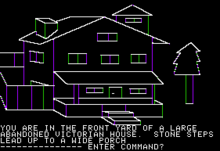Mystery House
| Mystery House | |
|---|---|
| Title screen | |
| Studio | On-line systems |
| Publisher | On-line systems |
| Senior Developer | Roberta Williams , Ken Williams |
| Erstveröffent- lichung |
May 5th 1980 |
| platform | Apple II , iOS , PC-8801 , PC-98 |
| Game engine | ADL |
| genre | Adventure |
| control | keyboard |
| medium | diskette |
| language | English |
Mystery House is an adventure game released by On-Line Systems for the Apple II in May 1980 . It was developed by computer game designer Roberta Williams and her husband, programmer Ken Williams . The game is considered a milestone, as it was the first time that it used two-dimensional graphics in an adventure game and not only presented the game in text form.
action
The story begins near an old Victorian mansion . A short time later, the player is locked in the house. During the search, he discovers various rooms and seven other people, but one of them is a murderer. There are some murders. The player has to find out who the killer is and who his next victim will be. The game is based on the detective story And then there was no more from Agatha Christie .
Game principle and technology
Mystery House is a text adventure, which means that surroundings and events are displayed as screen text and the actions of the player are also entered as text via the keyboard and processed by a parser . The lower fifth of the screen is used to enter commands and the parser's reactions to them, the upper 80% are reserved for the representation of the environment and what is happening in the form of schematic black and white graphics. The parser was about 300-400 words long, about half of what the grammatically much more complex parser of the earlier Zork could process.
Like many other games of the time, Mystery House is based on the overlay technique: only the text parser itself was kept in main memory; For the pictures including the shapes for the objects to be collected, further short machine programs were loaded.
Production notes
In the late 1970s, Ken Williams founded an enterprise software company for the then market-leading Apple II computer . One day he used a teletype machine to tell his wife about the development of his new bookkeeping system. He discovered the game Colossal Cave Adventure in a catalog . This game should have a huge impact on Mystery House . After the two of them finished Colossal Cave Adventure , they looked for something comparable. But the market for it was underdeveloped at the time, so they decided to design their own adventure game. Roberta Williams liked the concept of a text adventure, but she believed that images would be more impressive. Roberta Williams drew the pictures and Ken Williams programmed Mystery House . The game was distributed on a 5¼-inch floppy disk in a plastic bag, with brief instructions included. Mystery House was sold through local software stores and soon became a huge hit. A total of around 10,000 copies were sold. This was an unusual amount for the time. Some elements of the game also appeared in The Colonel's Bequest .
In 2009 an adaptation for mobile devices with the iOS operating system appeared . This was not developed by the rights holder Activision Blizzard , but by a private person.
reception
The Computer Gaming World praised the "wonderful Victorian Setting" of the game, but criticized the backward parser.
Web links
- Mystery House on the Internet Archive (with the option to play)
- Mystery House at MobyGames (English)
Individual evidence
- ↑ a b Computer Gaming World, January 1982, p. 31: On-Line Adventure Games. Retrieved December 2, 2016 .
- ↑ AdventureClassicGaming.com: Zork I: The Great Underground Empire. Retrieved December 2, 2016 .

